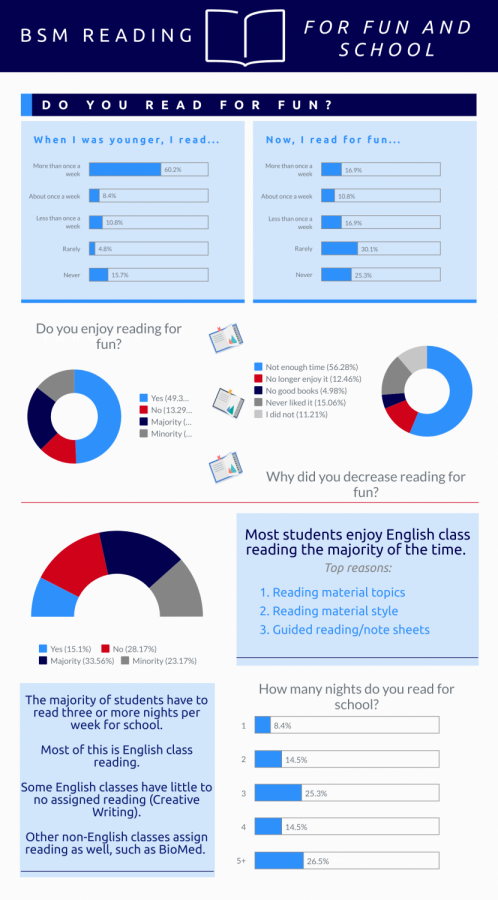Students’ share their reading habits
An infographic made from collected data shows the various reading trends among students.
As high school gets increasingly busy and stressful, students find themselves with limited time for a vital activity: reading. In a survey of 81 BSM students, 48.1% said that they enjoy reading for fun; however, only 17.3% of them can claim to read more than once a week. More and more, assigned reading for classes is taking the place of by-choice, for-fun reading that students used to enjoy as kids.
When they were younger, 59.3% of students surveyed read more than once a week. The love of reading can come from many factors. For many students, the enjoyment of reading stems from the ability to experience a new story. “[Reading is] kinda like a new experience… it changes how you think about things… I used to use that as a getaway,” freshmen Parker Morgan said.
Reading for classes, especially English classes, is hit-or-miss when it comes to engaging students. It’s not black and white: when surveyed, the majority of students (58%) indicated that they enjoy English reading “the majority of the time” or “the minority of the time,” rather than a concrete “yes” or “no.” This is partly due to the wide variety of books in English curricula. “[Enjoyment] depends on the book. When we had to read Pride and Prejudice, I don’t think anyone was okay with that. But Animal Farm was fun. And… the amount of reading that people are doing for a book… just depends what everyone thinks about it,” sophomore Max Jackson said.
English teachers constantly need to adapt their lesson plans to incentivize students to read books that kids may consider less interesting. Generally, this means adding more benchmarks to the reading plan. “Students… are encouraged to complete assigned reading by having assignments posted on PowerSchool Learning, by having a reading bookmark or reading schedule, sometimes by having reading quizzes regularly. [Quizzes] are, unfortunately, motivating factors for kids to complete assigned reading,” English department chair Ms. Katie Belanger said.
Although these assignments can be a motivating factor for students to complete the reading, they may not increase their overall interest in the book. One example of this is guided reading sheets, or note sheets that pair with reading. “If I’m reading these note sheets, I won’t really be paying attention to everything else… [if] question one is asking me whether or not this person said XYZ, and I won’t be focusing on anything else… I’m just looking for that one sentence,” junior Ernesto Rios-Diaz said.
One suggestion to make assigned reading more interesting is to increase the options. Rather than reading one book, students are given the option of several books to read. “I remember one time in [Ms.] Olsen’s class we were given an option of books to read and do a little report on that. I found that to be more intriguing and I was excited to read the book that I was given a choice to read,” Rios-Diaz said.
Allowing more choices for student reading has been tried with success. Ms. Belanger now has a shortlist of books for her Honors English 9 summer assignment; students choose one book to read before school starts. “Creating more choice in the freshman summer reading has had an impact on… the discussions that we had in class afterward. By allowing students to pick a book that they were more drawn to rather than everybody just reading Rash gave us a more lively and engaged starting point this year than in years past,” Belanger said.
This freedom to choose what they want to read is a major reason some students prefer reading for fun to reading for class. “If you read for fun, you learn more about what you want to learn about… when you’re reading for school you’re reading because it’s for an assignment… it’s passion versus an expectation,” Jackson said.
Even though more choices have made English reading more engaging in some classes, students still miss reading for fun. “I liked reading… I guess it’s kinda strange… now that I don’t have much time to read for fun, it’s basically what I read in English class. So that sucks because there’s not as much variety. But over the summer, I still just read for fun. That’s what I do,” freshman Aidan Marks said.
Ultimately, deciding to read for fun comes down to a lack of time. Of the 81 students surveyed, 53.1% of them said they have decreased reading for fun because they don’t have enough time. Regardless, English teachers continue to encourage them to read for fun. “Students are really pressed for time and I think that reading for fun is probably lower on their priority list than I would like it to be… I think students may be read for fun more during the summer. We’re trying to encourage more of this in 9th grade and 10th grade with independent reading, and by carving out that time in the school day for kids to read a book of choice because it’s important,” Belanger said.
Even when students find free time, reading is rarely number one on the priority list. Games, movies and social media are increasingly time-fillers for students. “I feel like it’s the digital age coming… I’ve moved more from books and stuff, something that’s not super interesting, to something like my phone or a movie that I’m always engaged in,” sophomore John Mulcahy said.
Although students may technically be ‘reading’ on social media platforms, teachers do not feel this can replace the experience of reading a full book. “You’re reading in different ways, where you’re reading Twitter, and you’re reading short articles, and you’re reading things that are not necessarily novels. It feels like you’re reading, but you’re not really getting immersed in anything,” English teacher Ms. Calli Olson said.
As reading for fun becomes less common and reading for class takes over, English teachers hope they can uphold the engagement and passion students have when they read books on their own time. “We hope that there is a value that students get out of [the books we assign], or joy in the discussion and the playfulness of it, or the lessons that are to be learned,” Belanger said.




































![Teacher Lore: Mr. Hillman [Podcast]](https://bsmknighterrant.org/wp-content/uploads/2025/03/teacherlorelogo-1200x685.png)





